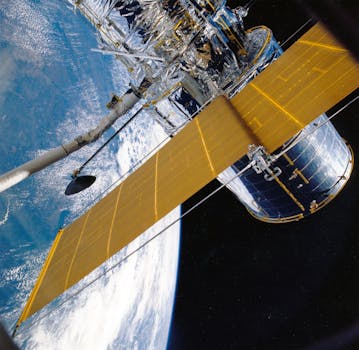GEO Satellites: Unlocking the Power of Geostationary Orbit

GEO Satellites: Introduction to Geostationary Orbit
GEO satellites, or Geostationary satellites, are a type of satellite that orbits the Earth at an altitude of approximately 36,000 kilometers above the equator. At this altitude, the satellite’s orbital period matches the Earth’s rotational period, allowing it to remain stationary relative to a fixed point on the Earth’s surface. This unique characteristic makes GEO satellites an essential component of modern satellite communications, enabling the transmission of data, voice, and video signals to a wide range of audiences around the world. GEO satellites have been in use for several decades, with the first geostationary satellite, Syncom 2, launched in 1963. Since then, the technology has evolved significantly, with modern GEO satellites offering higher bandwidth, improved signal quality, and increased reliability. Today, GEO satellites play a critical role in various applications, including telecommunications, broadcasting, weather forecasting, and navigation.
How GEO Satellites Work
GEO satellites operate by transmitting and receiving signals to and from Earth stations, which are typically located on the ground or on other satellites. The signals are transmitted through a series of antennas and amplifiers, which boost the signal strength to compensate for the long distance between the satellite and the Earth station. The signals are then received by the Earth station, where they are processed and distributed to the intended audience. One of the key benefits of GEO satellites is their ability to provide continuous coverage of a specific region or audience. Since the satellite remains stationary relative to a fixed point on the Earth’s surface, it can maintain a constant signal strength and quality, making it ideal for applications that require high availability and reliability. Additionally, GEO satellites can be used to transmit signals to multiple Earth stations simultaneously, allowing for efficient use of bandwidth and resources.
Applications of GEO Satellites
GEO satellites have a wide range of applications, including telecommunications, broadcasting, weather forecasting, and navigation. In the telecommunications sector, GEO satellites are used to provide internet connectivity, voice services, and data transmission to remote or underserved areas. They are also used to support mobile networks, providing backup connectivity during outages or periods of high traffic. In the broadcasting sector, GEO satellites are used to transmit television channels, radio stations, and other multimedia content to a wide range of audiences. They are also used to support video conferencing, distance learning, and other applications that require high-quality video transmission. In addition to these applications, GEO satellites are also used for weather forecasting, providing images and data on cloud patterns, storms, and other weather phenomena. They are also used for navigation, providing location information and timing signals to support GPS and other navigation systems.
Benefits and Challenges of GEO Satellites
GEO satellites offer several benefits, including high availability, reliability, and continuous coverage of a specific region or audience. They are also relatively low-cost compared to other types of satellites, making them an attractive option for many applications. However, GEO satellites also have some challenges, including signal latency, interference from other satellites, and the risk of orbital congestion. To mitigate these challenges, satellite operators and manufacturers are developing new technologies and strategies, such as advanced signal processing, beamforming, and orbital management. These innovations are helping to improve the performance and efficiency of GEO satellites, enabling them to support a wider range of applications and services.
Conclusion
GEO satellites are a crucial part of modern satellite communications, offering a wide range of benefits and applications. Their ability to provide continuous coverage of a specific region or audience, combined with their high availability and reliability, makes them an essential component of many telecommunications, broadcasting, and navigation systems. As the demand for satellite services continues to grow, the importance of GEO satellites will only continue to increase, driving innovation and investment in this critical sector.
